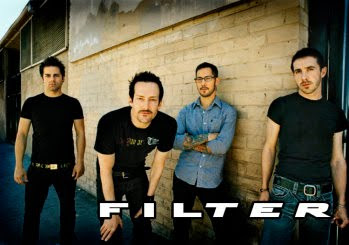
Well, no, not THAT filter. We're talking about synth filters. Sorry, Richard Patrick. Maybe next time.
As you’ll recall, we already discussed the basic function of a filter is to filter out frequencies past a user-defined “cutoff” point. But how do we know if it’s going to filter off the frequencies above or below the cutoff frequency? That’s where filter type comes in.
The LOWPASS filter is by far the most common type of filter you’ll come across. In fact, especially on older synths, it may be the ONLY type of filter you find. A lowpass filter filters out the frequencies above the cutoff value. In other words, it lets the frequencies beLOW the cutoff to PASS through. Get it? Low cutoff values will sound very dark and muffled (if at all), and as you increase the cutoff value, the sound will get brighter as you allow more high frequencies through. A healthy majority of the electronic sounds you have heard were probably made with a lowpass filter. Here is an example with 2 sawtooth oscillators, detuned a bit, and fed through a lowpass that sweeps from a low cutoff value to a high one and back:
A HIGHPASS filter is the exact opposite of a lowpass filter. It allows only frequencies ABOVE the cutoff point through (it lets the frequencies HIGHer than the cutoff frequency PASS through), so as you increase the cutoff value, more and more low frequencies are filtered out. The higher the cutoff, the less bassy the sound will get until you’re left with only the high frequencies, and eventually, nothing is left. Depending on how they're used, highpass filters can sound light and airy, or aggressive and acidic and get a lot of use in the Goa/Psytrance music. Here's the same sound as above, but sent through a highpass filter:
A BANDPASS filter is sort of what you would expect if a lowpass and a highpass filter were combined (in fact, you can replicate a bandpass filter if you have both a lowpass and highpass simultaneously available like on the Korg MS-20). A bandpass filter filters off the frequencies both above AND below the cutoff frequency, leaving only a relatively narrow BAND of frequencies PASS through. Bandpass filters have a sort of nasal quality and add a really nice variation from the more standard lowpass and highpass filters. Here's our example sound, but this time it's being fed through a bandpass filter.
You may recall that when we first started talking about filters, I mentioned how filters could be used to simulate the way a guitar sound goes from a bright initial sound, fading to a more muted sustain. Having these filters is great, but if you just leave it set to a static cutoff value, all you really have is a glorified bass/treble knob. Sure, if your synth has knobs, you could manually change the cutoff value with each note you played to emulate this effect, but wouldn’t it be great if there was a way your synth could do this automatically for you? Actually, it can! Next post, I’ll introduce the concept of MODULATION to you and you’ll begin to see how a synthesizer can achieve more interesting, dynamic sounds out of the relatively simple architecture we’ve discussed so far.




















1 comment:
So much useful data for everyone!
Post a Comment